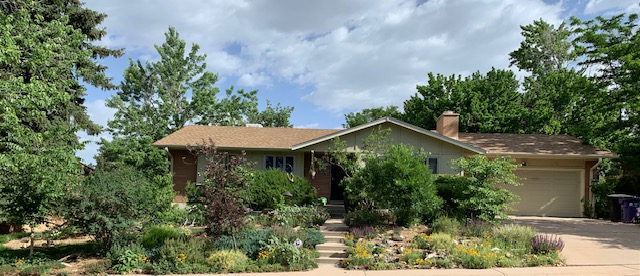An alternative to green lawns that helps both climate and critters
Denver, Colorado
Why do we have green lawns? Habit, I suppose as well as perceived peer pressure from neighbors. And yet, some 20 years ago when my partner, Judy, tore out part of our front lawn replacing it with xeriscape (drought-tolerant) plants, a local garden club gave her an award. Instead of criticism, some neighbors have been inspired to take their lawns in several different directions, replacing grass with native plants, shrubs, trees, flower beds, and rock gardens.
Thanks to Judy’s
efforts, our front yard in southeast Denver is dominated by drought-tolerant
plants and trees. Fortunately, there are
no neighborhood covenants that stopped us from tearing out our mostly
crab-grass lawn more than 20 years ago. Photo by Judy Greenfield
In relatively dry Denver, the recommended approach 20 years
ago was xeriscaping. But rather than
drought-tolerant plants in general, plants native to a local area are now preferred for
natural landscaping, whether one lives in toasty Tucson or humid Houston. But how does replacing a Kentucky bluegrass
lawn with native plants help mitigate the climate catastrophe?
- Native trees, shrubs, grasses, and flowers take CO2
from the atmosphere and store it in the soil.
This includes contributions from photosynthesis and decomposition of
leaf litter.
- Native trees and shrubs provide shade for homes reducing
energy consumption for air conditioning. They also counteract the "heat island
effect" resulting from the urban concentration of concrete, asphalt, bricks, and
roofing materials.
- Cumulatively, the 50 million acres of U.S. lawns require
200 million gallons of gasoline per year for mowing. That’s a whole lot of unnecessary CO2
emissions to the atmosphere.
- Growing native plants eliminates the need for synthetic
fertilizers. The latter disrupt the natural
relationship with plants and soil microorganisms which accelerates the release
of carbon into the atmosphere. Shipping
fertilizer from manufacturer to consumer also adds to CO2 emissions.
- In addition to the positive effects on greenhouse gas
emissions, native plants virtually eliminate the need for watering. Choosing plants that are native to the local
area usually ensures that the plants can survive on the water provided by rain and snow
once they have become established.
- Native plants also provide habitat for local birds and
insects which promote pollination and the health of the local ecosystem and are
pleasant to have in one’s yard.
In the spring, this area in front of our house is a riot of orange California poppies. They are not natives but do well in Denver’s climate with little need for watering once established. Photo by Judy Greenfield
Sounds great but maybe you are concerned that there is lots
of work and expense involved in replacing a lawn with native plants. That may be true in the short run but
consider the long-term advantages:
- Required weekly or bi-weekly lawn mowing is eliminated
freeing up time for other more fun stuff.
- No more watering once plants are established and no maintaining sprinkler systems.
- No need to fertilize, apply herbicides, and aerate every
year.
- You can create some aesthetic diversity in the spaces
around your home instead of having a boring green lawn that looks like every
other neighbor’s boring green lawn.
What if you live in a condominium or a covenant-controlled
community that mandates standard lawns and forbids their replacement with
native plants? You can lobby the board
of directors to update their rules in response to the climate crisis. If they are stubborn, narrow-minded old shits
that won’t listen to reason, find some like-minded neighbors and get your board
thrown out at the next election. Or sue
their asses. Courts are becoming more
sympathetic to climate-related issues.
To find out more about creating and maintaining climate
resilient landscapes around your home, contact Wild Ones (wildones.org), a
national non-profit organization that provides resources and education on this
topic. Some cities have Wild Ones
chapters. In addition, there are local
organizations like the Colorado Native Plant Society (conps.org) that promote
and protect native plants.





We love seeing your lawn when we drive up to your house. As for us, our front lawn is all of 15' x 15', not worth worrying about. We did the native plants thing in the back last fall. Anyone want a squash the size of a Great Dane?
ReplyDelete